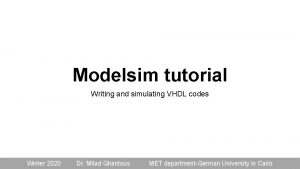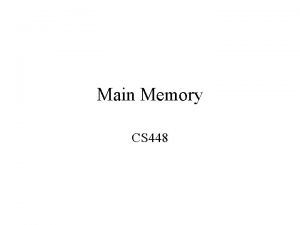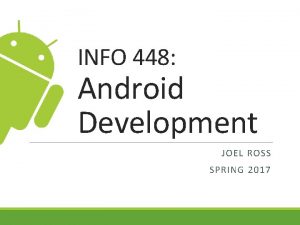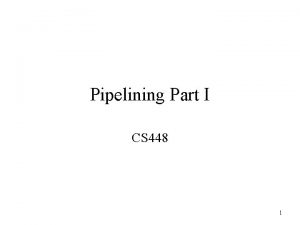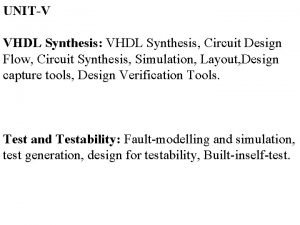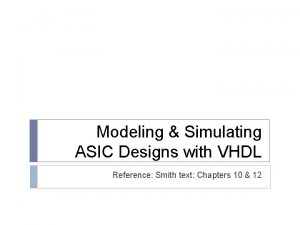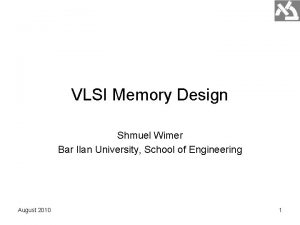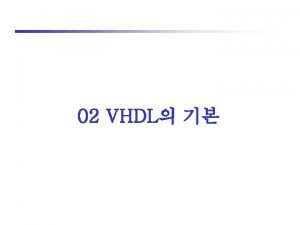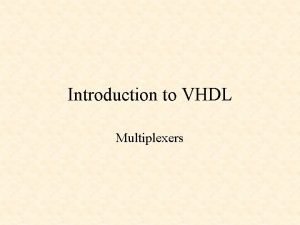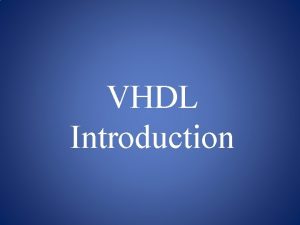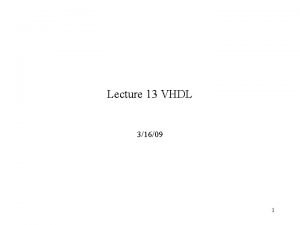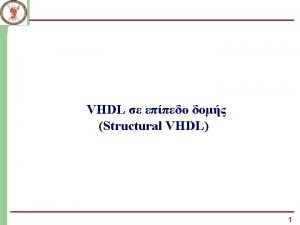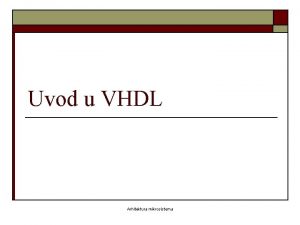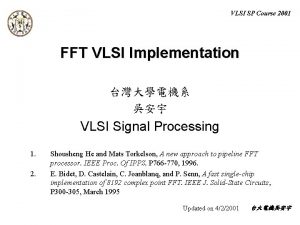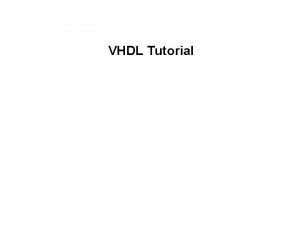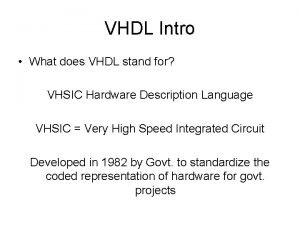INTRO TO VLSI DESIGN CPE 448 VHDL Tutorial






















- Slides: 22

INTRO TO VLSI DESIGN (CPE 448) (VHDL Tutorial) Prof: Asuif Mahmood

} Files can be used to store data to be loaded into a model when it is run, or to store the results produced by simulation. } VHDL also provides specialized versions of file operations for working with text files. } VHDL provides sequential access to files using operations, such as “open”, “close”, “read” and “write”, that are familiar to users of conventional programming languages. } File Declarations: file identifier { , … }: subtype_indication [[ open file_open_kind_expression ] is string_expression] FILES and INPUT/OUTPUT

} If a file is opened in a read mode, successive elements of data are read from the file using the read operation. } Reading starts from the first element in the file, and each time an element is read the file position advances to the next element. } We can use the endfile operation to determine when we have read the last element in the file. Syntax: type file_type is file of element_type; read and endfile operations are implicitly declared as procedure read ( file f : file_type; value : out element_type); function endfile ( file f : file_type) return boolean; Reading from Files

Library ieee; Use ieee. std_logic_1164. all; entity ROM is generic (load_file_name : string); port( sel : in std_logic; address : in std_logic_vector; data : in std_logic_vector); end entity ROM; architecture behavioral of ROM is begin behavior : process is subtype word is std_logic_vector( o to data’length – 1); type storage_array is array (natural range 0 to 2**address’length – 1 ) of word; variable storage : storage_array; variable index : natural; --other declarations type load_file_type is file of word; file load_file: load_file_type open read_mode is load_file_name; begin --load ROM contents from load_file index : = 0; while not endfile (load_file) loop read ( load_file, storage(index)); index : = index + 1; end loop; --respond to ROM accesses loop --- other instructions end loop; end process behavior; end architecture behavioral; Reading from Files (Example)

} If a file is open in write mode, a new empty file is created in the host computer’s file system, and successive data elements are added using the write operation. } implicitly declared as procedure write ( file f : file_type; value : in element_type); Writing to Files

architecture instrumented of CPU is type count_file is file of natural; file instruction_counts: count_file open write_mode is “instructions”; begin interpreter : process is variable IR : word; alias opcode : byte is IR(0 to 7); variable IR : word; type counter_array is array (0 to 2**address’length – 1 ) of natural; variable counters : counter_array: =(others =>0); begin --initialize the instruction set interpreter instruction_loop: loop --fetch the next instruction into IR --decode the instruction opcode_number : = convert_to_natural(opcode); counters(opcode_number) : = counters(opcode_number)+1; -- execute the decoded instruction case opcode is when halt_opcode => exit instruction_loop; end case; end loop instruction_loop; for index in counters’range loop write (instruction_counts, counters(index)); end loop; wait; -- program finished, wait forever end process interpreter; end architecture instrumented; Writing to Files (Example)

} The concept of type is very important when describing data in a VHDL model. } The type of a data object defines the set of values that the object can assume, as well as the set of operations that can be performed on those values. } A scalar type consists of single, indivisible values. Scalar Data Types and Operations

} Both constants and variables need to be declared before they can be used in a model. } A declaration simply introduces the name of the object, defines its type and may give it an initial value. constant number_of_bytes : integer : = 4; constant number_of_bits : integer : = 8*number_of_bytes; constant e : real : = 2. 71828; constant prop_delay : time : = 3 ns; variable index: integer : = 0; variable start, finish : time : = 0 ns; CONSTANTS and VARIABLES

} Example: architecture sample of ent is constant pi : real : 3. 14159 begin process is variable counter : integer; begin --do anything end process; end architecture sample; } One restriction on where a variable declaration may occur is that it may not be placed so that the variable would be accessible to more than one process. } The exception to this rule is if a variable is declared specially as shared variable. CONSTANTS and VARIABLES (cont. )

} A scalar type is one whose value are indivisible. } type apples is range 0 to 100; } type oranges is range 0 to 100; package int_types is type small_int is range 0 to 255; end package int_types; use work. int_types. all; entity smaller_adder is port ( a, b s end entity small_adder; : : in small_int; out small_int); SCALAR TYPES

} A predefined type integer is included, which includes all whole numbers representable on a particular host computer. type day_of_month is range 0 to 31; type year is range 0 to 2100; variable today: day_of_month : = 19; variable start_year: year : = 2002; **It is illegal to make the assignment: start_year : = today; INTEGER TYPES

type INPUT_LEVEL is range – 10. 0 to 10. 0; type probability is range 0. 0 to 1. 0; variable input_A: input_level; FLOATING-POINT TYPES

} Examples: type resistance is range 0 to 1 E 9 units ohm; kohm = Mohm = end units resistance; **We can use them as 5 ohm 22 ohm 1000 ohm; 1000 kohm; 4 kohm type time is range implementation defined units fs; ps=1000 fs; ns=1000 ps; us=1000 ns; ms=1000 us; sec=1000 ms; min=60 sec; hr=60 min; end units time; PHYSICAL TYPES

type alu_function is (disable, pass, add, subtract, multiply, divide); type octal_digit is ( ‘ 0’, ‘ 1’, ‘ 2’, ‘ 3’, ‘ 4’, ‘ 5’, ‘ 6’‘, 7’); variable alu_op: alu_function; variable last_digit: octal_digit : = ‘ 0’; and make assignments to them: alu_op : = last_digit : = subtract; ‘ 7’; ENUMERATION TYPES

} When we write complex behavioral models it is useful to divide the code into sections, each dealing with a relatively selfcontained part of the behavior. } There are two kinds of subprograms: procedures and functions. } Procedure encapsulates a collection of sequential statements that are executed for their effect. } Function encapsulates a collection of statements that compute a result. } Thus a procedure is a generalization of a statement, whereas a function is a generalization of an expression. Subprograms

} There are two aspects to using procedures in a model: } First the procedure is declared. } Then elsewhere the procedure is called. procedure identifier [ (parameter_interface_list) ] is { subprogram_declarative_part } begin { sequential_statement } end procedure [ identifier ]; PROCEDURES

procedure addu ( a, b : in word 32; result : out word 32; overflow : out Boolean ) is variable sum: word 32; variable carry: bit : = ‘ 0’; begin for index in sum’reverse_range loop sum(index): =a(index) xor b(index) xor carry; carry: =(a(index) and b(index) ) or (carry and (a(index) xor b(index) ) ); end loop; result: =sum; overflow: =carry = ‘ 1’; end procedure addu; **A call to this procedure may appear as follows: variable PC, next_PC: word 32; variable overflow_flag: boolean; addu ( PC, X” 0000_0004”, next_PC, overflow_flag); PROCEDURES (Example)

} The syntax rule for a function declaration is very similar to that for a procedure declaration: function identifier [ (parameter_interface_list) ] return type_mark is { subprogram_declarative_part } begin { sequential_statement } end function [ identifier ]; FUNCTIONS

function limit ( value, min, max : integer) return integer is begin if value > max then return max; elsif value < min then return min; else return value; end if; end function limit; } Call to this function might be included in a variable assignment statement, as follows: new_temperature : = limit ( current_temperature + increment, 100); FUNCTIONS

} A VHDL package is simply a way of grouping a collection of related declarations that serve a common purpose. } They might be a set of subprograms that provide operations on a particular type of data. } Or they might just be the set of declarations needed to model a particular design. } The important thing is that they can be collected together into a separate design unit that can be worked on independently and reused in different parts of a model. package identifier is { package_declarative_item } begin { sequential_statement } end package [ identifier ]; Package

package cpu_types is constant word_size : positive : = 16; constant address_size : positive : = 24; subtype word is bit_vector (word_size-1 downto 0); subtype address is bit_vector (address_size-1 downto 0); type status_value is (halted, idle, fetch, mem_read, mem_write, io_read, io_write, int_ack); subtype opcode is bit_vector (5 downto 0); function extract_opcode (instr_word: word) return opcode; constant op_nop : opcode : = “ 000000”; constant op_breq : opcode: = “ 000001”; constant op_brne : opcode: = “ 000010”; constant op_add : opcode : = “ 000011”; end package cpu_types; Package (Example)

entity address_decoder is port ( addr : in work. cpu_type. address; status : in work. cpu_type. status_value; mem_sel, int_sel, io_sel : out bit); end entity address_decoder; architecture behavioral of cpu is -- define constant mem_low: work. cpu_type. address: =X” 000000”; begin interpreter : process is variable instr_reg : work. cpu_types. word; variable instr_opcode : work. cpu_types. opcode; begin -- initialize loop -- fetch instruction instr_opcode: = work. cpu_types. extract_opcode( instr_reg): case instr_opcode is when work. cpu_types. op_nop => null; when work. cpu_types. op_breq => null; end case; end loop; end process interpreter; end architecture behavioral; Package (Example)
 Vlsi design tutorial
Vlsi design tutorial Vlsi design tutorial
Vlsi design tutorial Intro to vlsi
Intro to vlsi Modelsim tutorial vhdl
Modelsim tutorial vhdl Array in vhdl tutorial
Array in vhdl tutorial Afsc 448 scmw saspo
Afsc 448 scmw saspo Jest głównym dopływem wisły ma 448 km długości
Jest głównym dopływem wisły ma 448 km długości Cs 448
Cs 448 Joel ross uw
Joel ross uw 500 - 448
500 - 448 Ece 448
Ece 448 Ece 448
Ece 448 Ece 448
Ece 448 Cs 448
Cs 448 Factors of 448
Factors of 448 Ece 448
Ece 448 Ece 448
Ece 448 Ece 448
Ece 448 Vhdl design flow
Vhdl design flow Vhdl design flow
Vhdl design flow Pld
Pld Memory design in vlsi
Memory design in vlsi Vlsi design flow y chart
Vlsi design flow y chart



